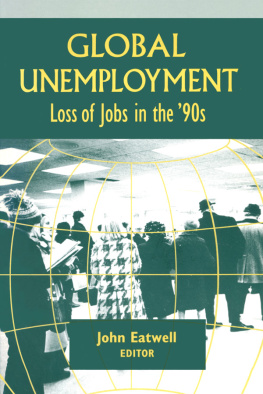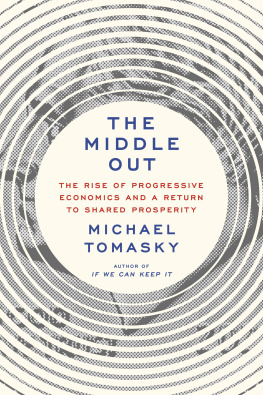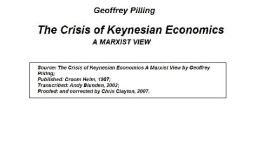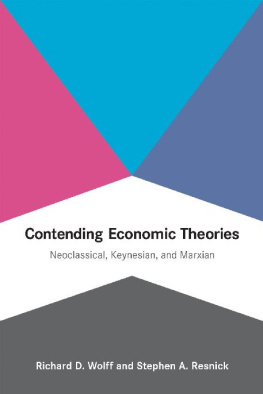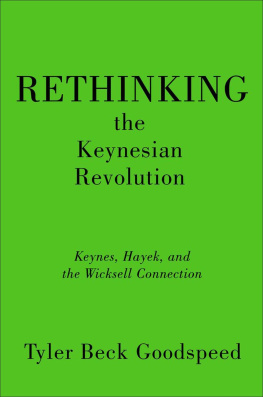The Fall and Rise of Keynesian Economics
Finance and the Economy
A CERF Series edited by John Eatwell
The Cambridge Endowment for Research in Finance (CERF) was founded in 2001 as an independent resource at the University of Cambridge. It is dedicated to developing an enhanced understanding of the evolution and behaviour of financial markets and institutions, notably in their role as major determinants of economic behaviour and performance. CERF promotes theoretical, quantitative and historical studies, crossing conventional disciplinary boundaries to bring together research groups of economists, mathematicians, lawyers, historians, computer scientists and market practitioners. Particular attention is paid to the analysis of the impact of financial market activity on the formulation of public policy. As well as individual research projects, CERF funds Cambridge Finance, the organisation that brings together researchers in finance from all departments of Cambridge University. The CERF series of publications on Finance and the Economy embodies new research in these areas.
Global Governance of Financial Systems: The International Regulation of Systemic Risk
Edited by Kern Alexander, Rahul Dhumale, and John Eatwell
Identifying International Financial Contagion: Progress and Challenges
Edited by Mardi Dungey and Demosthenes N. Tambakis
Transmission of Financial Crises and Contagion: A Latent Factor Approach
Edited by Mardi Dungey, Rene A. Fry, Brenda Gonzlez-Hermosillo, and Vance L. Martin
The Fall and Rise of Keynesian Economics
John Eatwell and Murray Milgate
The Fall and Rise of Keynesian Economics
JOHN EATWELL AND MURRAY MILGATE


Oxford University Press, Inc., publishes works that further
Oxford University's objective of excellence
in research, scholarship, and education.
Oxford New York
AucklandCape TownDar es SalaamHong KongKarachi
Kuala LumpurMadridMelbourneMexico CityNairobi
New DelhiShanghaiTaipeiToronto
With offices in
ArgentinaAustriaBrazilChileCzech RepublicFranceGreece
GuatemalaHungaryItalyJapanPolandPortugalSingapore
South KoreaSwitzerlandThailandTurkeyUkraineVietnam
Copyright 2011 by Oxford University Press, Inc.
Published by Oxford University Press, Inc.
198 Madison Avenue, New York, New York 10016
www.oup.com
Oxford is a registered trademark of Oxford University Press
All rights reserved. No part of this publication may be reproduced,
stored in a retrieval system, or transmitted, in any form or by any means,
electronic, mechanical, photocopying, recording, or otherwise,
without the prior permission of Oxford University Press.
Library of Congress Cataloging-in-Publication Data
Eatwell, John.
The fall and rise of keynesian economics /
John Eatwell and Murray Milgate.
p. cm.
Includes bibliographical references and index.
ISBN 978-0-19-977769-3 (cloth. : alk. paper)
1. Keynesian economics. 2. Economic history19181945.
3. Economic history1945I. Milgate, Murray. II. Title.
HB99.7.E26 2011
330.156dc222010032103
1 3 5 7 9 8 6 4 2
Contents
Preface
The global financial crisis and the world recession it produced were the latest in a series of crises that have come to plague the international economy. Such crises have become increasingly frequent and more intense as the liberalization of financial markets accelerated after the collapse of the Bretton Woods system some forty years ago. That each of them cannot be treated as an isolated event with solitary causes, but were instead events that shared common origins, has become clear to us all. Their origins, we now find, reside in part in the consequences of a process of financial liberalization that was allowed to proceed without sufficient consideration being given to the magnification of systemic risk it entailed, and in part in the consequences of the neoliberal dogmas that came to dominate practical policymaking during those same years.
The almost hypnotic power of these failed dogmas should not be underestimated. There are grown men and womensome even among professional economistswho continue to maintain that there are no multiplier effects to be had from loan expenditure undertaken by governments during a slump. It is still possible to hear the wrong-headed opinion that while an increase in public indebtedness during a recession is to be avoided at all costs, an increase in the aggregate of private indebtedness on a similar scale (supposedly easily engineered simply by getting credit channels flowing) offers an entirely unproblematic solution to our present problems.
There remain a few academic economists continuing to promote the perverse idea that in times of actual or threatened deflation, widespread spare capacity, and involuntary unemploymentwith world growth, effective demand, and investor and consumer confidence all fragilewe should focus all our attention on the remote possibility of inflation down the line. There are politicians who warn us that by borrowing for current spending we are transferring the burden of repayment to future generations, apparently not noticing that if we actually had such magical powers, future generations would simply use them to do the same thing when the time came.
There are authorities and policymakers urging us to do something about the huge budget deficit; and there are not a few European governments actually instituting swinging cuts in public spending to reduce the ratio of the deficit to GDP (some of them, admittedly, against their will)seemingly without any discernable concern for the economic consequences of what they are saying and doing. Even when school-children begin to learn about fractions, one of the first things they are taught is that a fraction can be lowered either by reducing its numerator or increasing its denominator (or by doing a bit of both). But when that fraction is the ratio of the budget deficit to GDP, it is surprising how many seem to forget entirely their elementary arithmetic and proceed to speak as if the only way to reduce that ratio is to cut the deficit. This would be misleading enoughsince the objective might just as well be achieved by thinking of ways of increasing GDPbut it is positively crazy if cutting expenditure may decrease GDP. This is a lesson that the European Union has chosen to learn the hard wayas governments from Greece and Ireland, through to Italy, Spain, Portugal, Germany, and Britain, are slashing public expenditures to reduce the deficit. The U.S. administration is understandably concerned.
Then there is the national debt to be considered. Should this be as worrying a thing in our present circumstances as we are led to believe it is? Those who urge us to think so, often speak of it as a mountain of debt. They mention, for example, that in the United States during 2010 it was increasing by $3.8 billion every daynot noticing that without some point of reference, this number on its own is completely meaningless. Or they talk about the ratio of debt to GDP and the mess we are in because of itforgetting that the mess we are in is the result of a global recession (caused by a financial crisis) from which recovery appears to be slow at best. Moreover, just what this particular ratio actually tells us about how vulnerable we are, since it is the ratio of a stock to a flow, is difficult to say. If we imagine that it has reached, say, one to one (100%), what would that mean? Before answering, it is well to remember that for most ordinary citizens with a mortgage, the ratio of their
Next page

